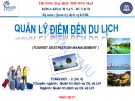
65
HNUE JOURNAL OF SCIENCE
Social Sciences 2024, Volume 69, Issue 4, pp. 65-76
This paper is available online at https://hnuejs.edu.vn/
DOI: 10.18173/2354-1067.2024-0068
ESTABLISHING A SCALE TO ASSESS THE FACTORS AFFECTING THE
COMPETITIVENESS OF TOURIST DESTINATIONS,
A CASE STUDY IN HOI AN CITY, QUANG NAM PROVINCE
Le My Dung1, Nguyen Phu Thang2*, and Nguyen Thi Hong2
1Faculty of Geography, Hanoi National University of Education, Hanoi city, Vietnam
2Faculty of Geography, The University of Da Nang,
University of Science and Education, Da Nang city, Vietnam
*Corresponding author: Nguyen Phu Thang, e-mail: npthang@ued.udn.vn
Received October 14, 2024. Revised November 5, 2024. Accepted November 6, 2024.
Abstract. The competitiveness index of tourist destinations is essential for attracting visitors
and adequately addressing their needs. Given that competitiveness is influenced by numerous
factors, it is essential to create a scale for assessing these factors. This study developed a
scale to evaluate factors affecting competitiveness in Hoi An city, Quang Nam province, a
notable tourist destination recognized for the World Cultural Heritage site of Hoi An ancient
town. The research employed descriptive statistics, utilizing Mean and Standard Deviation
to develop a scale comprising seven-factor categories and 64 rating criteria. The preliminary
results indicate that visitors largely concur with most groupings of elements affecting Hoi
An's competitiveness; however, several issues related to infrastructure and connectivity
require attention in the destination's tourism development.
Keywords: Competitiveness, tourist destination, scale, Hoi An city, Quang Nam province.
1. Introduction
With the increasing number of tourists around the world, tourist destination must constantly
increase their competitiveness to attract more visitors. As a result, competitiveness has become
an important criterion in determining the direction of destination tourism development. Ritchie
and Crouch's model defines competitiveness as a combination of comparative and competitive
advantages for a tourism destination [1]. Comparative advantage is defined as a destination's
endowment of resources (natural or cultural attractors), supporting resources (infrastructure,
accommodation, tourist facilities), and destination management (managerial capabilities of a
destination), whereas competitive advantage focuses on the efficiency and effectiveness with
which those resources are managed. Over the last decade, there has been an increasing interest in
assessing the Competitiveness of Tourist Destinations (CTD) and identifying the variables that
assist destinations in improving their standing. There are studies in the tourism literature that aim
to rank countries based on tourism destinations' resources and policies, with a focus on the
comparative advantage dimension of competitiveness.
Numerous tourism studies indicate that the CTD comprises various variables. Crouch and
Ritchie define the factors that draw resources to a destination as the destination's attractiveness,
which defines its competitiveness. They include natural elements, climate, cultural characteristics,
infrastructure, attitudes toward tourists, costs, prices, socio-economic relationships, and the
















